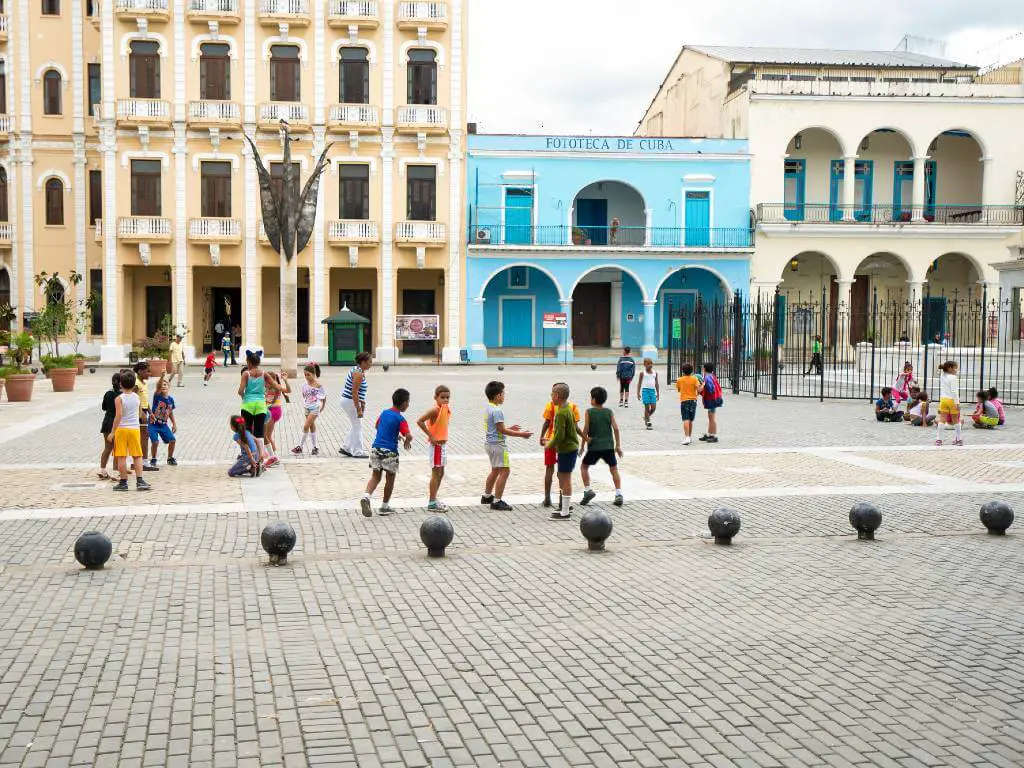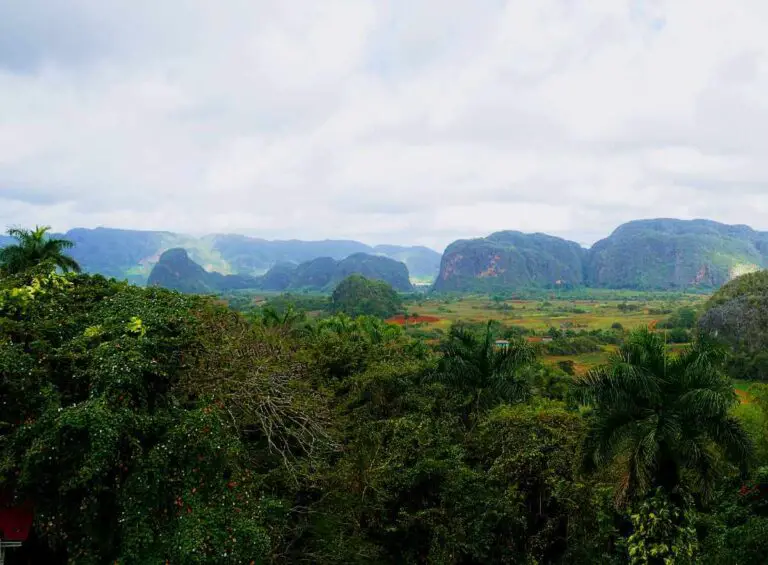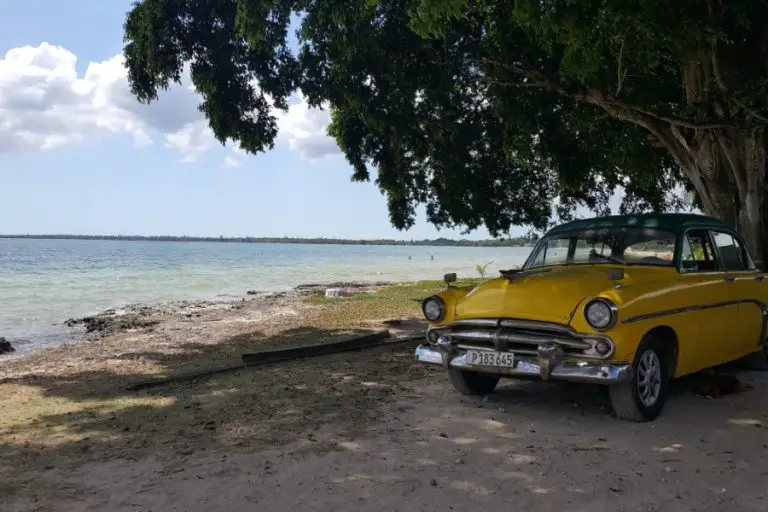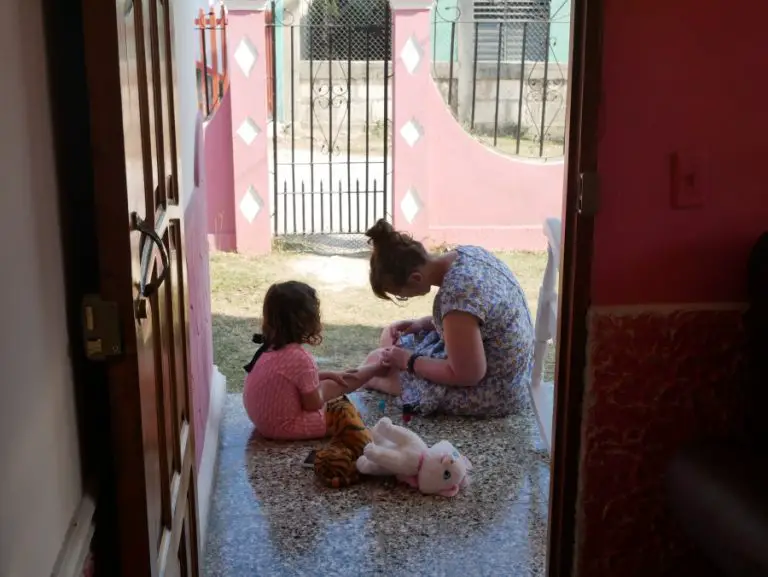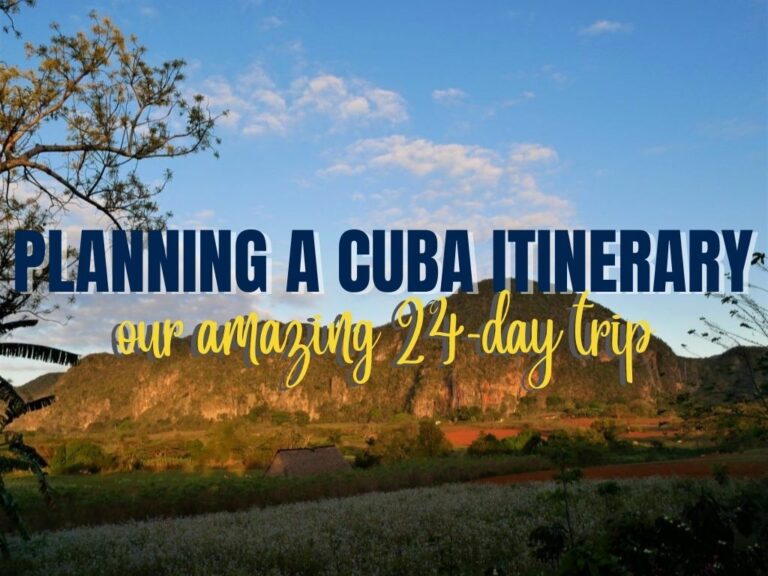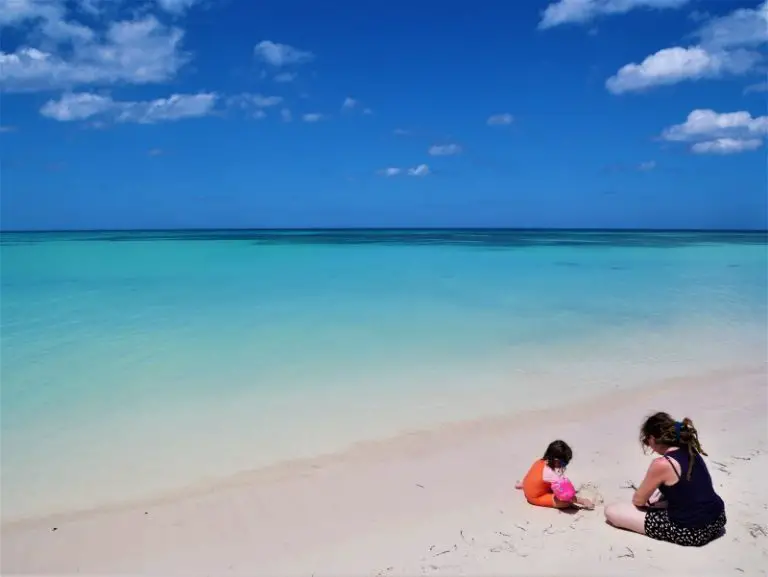8 Exciting Activities in Havana with Kids (+ a complete travel guide)
When one thinks of Havana, a few things typically come to mind. Soulful Latin music, humid afternoons, old architecture, and delectable cocktails; you know, fun things usually reserved for adult travelers. You’d be surprised to learn that there are as many kid-friendly attractions to see here if you know where to look! Read on to know about the best things to do in Havana with kids.
There’s a good chance this post contains affiliate links. This means that if you purchase anything through one of our links, we’ll receive a small fee (it won’t cost you anything, promise!). As an Amazon Affiliate, we earn from qualifying purchases. If you would like to learn more about our affiliate partners, click here for our disclaimer.
Things to Do in Havana With Kids
Ride a classic car and do a photoshoot
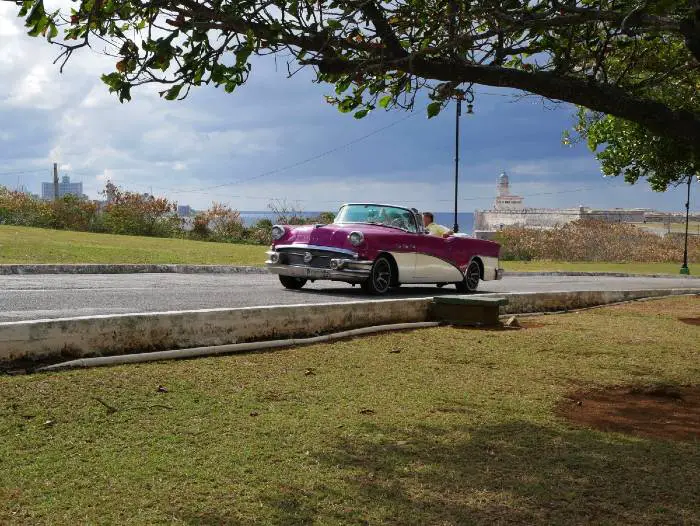
Though some may argue that the act is a little cliché, trust me when I say it doesn’t make riding around Havana in a bright pink car any less fun. There are a couple of ways to book a classic car ride. You can do this online, or you can visit common tourist spots such as the Parque Central, the Museo de la Revolución, or the Plaza de la Libertad to arrange a trip.
Be mindful of the price, since a 1-hour tour should not cost more than $35. This price is for the entire ride, not per person. Regardless of your budget, I would say it’s money well spent; especially after you post your family photos on your socials!
Play at the Different Plazas of Havana Vieja
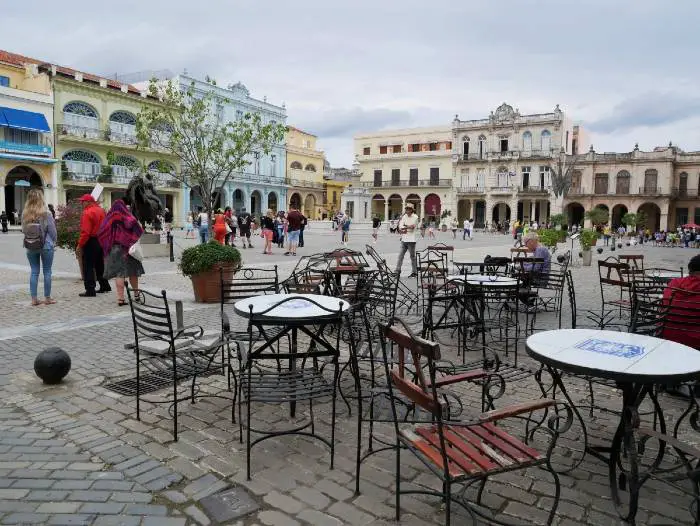
Havana Cuba with kids wouldn’t be complete without a casual afternoon stroll through the historic center known as Havana Vieja (directly translates to old Havana). Declared by UNESCO as a World Heritage Site in 1982, Havana Vieja gives visitors a glimpse of the culture and feel of 1950s Cuba.
There are four main squares in Havana Vieja. Namely, Plaza de la Catedral, Plaza Vieja, Plaza de San Francisco, and the Plaza de Armas. Outside of these more “commercial” areas, you’ll understand why you absolutely cannot skip out on this part of your trip. Beautifully maintained colonial-style buildings, colorful structures both new and old, and a rich variety of restaurants and food carts; this place encapsulates the very essence of Havana.
Understanding the history of Plaza Vieja (Old Square) is essential to making the most out of your trip. While it may now function mainly as a tourist and commercial hub, it once served a more fundamental purpose as Havana’s de facto venue for important local events. In the old times, these included executions, fiestas, processions, and the like. Personally, I find it fascinating that this place has successfully transitioned into the wholesome, animated attraction that it is today.
Aside from the brightly colored classic cars for rent, you can also enjoy a fun family ride in a horse-drawn carriage, and indulge your kids in a quick game of soccer in some of the spacier and less crowded plazas before recharging with a serving of some delectable Cuban churros!
Cañonazo at Cabana fort
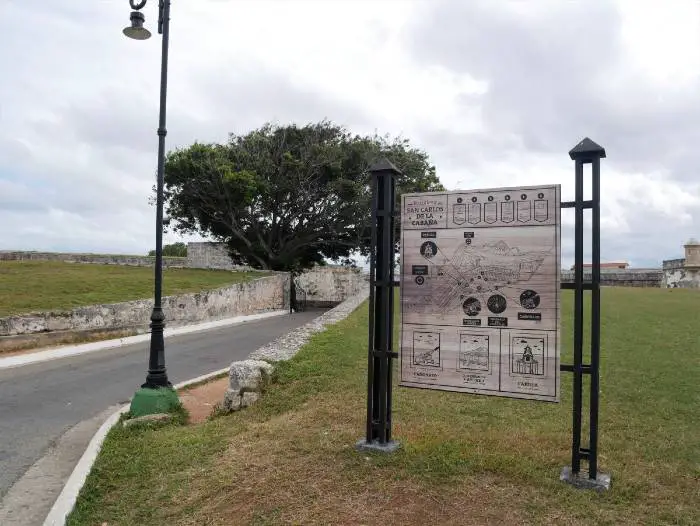
During the Spanish occupation of Cuba in the 15th century, the daily curfew of the Havana harbor closed regularly at 9 pm and was signaled by a single cannon shot. Today, the ceremony continues as a local and tourist amusement. It’s not just a perfunctory attempt to portray an old practice either. They really go all out to re-enact the actual routine of the past, full traditional costumes and all!
While the ceremony itself may start a little late (making it a bit impractical for travelling families with younger kids), the architecture and history of this location make it worth visiting even during the daytime. While the adults admire the view and enjoy the atmosphere, younger visitors can snap pictures and update their socials in real-time because this place has great wifi and reception!
Rent a Swimming Pool for a Day
Even if you’re not staying in a hotel in Havana, there are numerous establishments that allow you to rent out their swimming pool for a day; a surefire way to get your kids pumped and excited for the trip! Depending on where you go, there should be a variety of deals to choose from.
Some pool rentals include food, while some may only offer the pool and the space. A sample deal would be $100 USD for a pool that accommodates up to 20 people for a set number of hours, with no food included in the package.
Regardless of the deal, you choose to go with, having a pool party in a foreign country on vacation is one of the fanciest ways to both flex and relax, at a pretty reasonable price I might add!
Take the Hop-On, Hop-off Bus Through the Center of Town
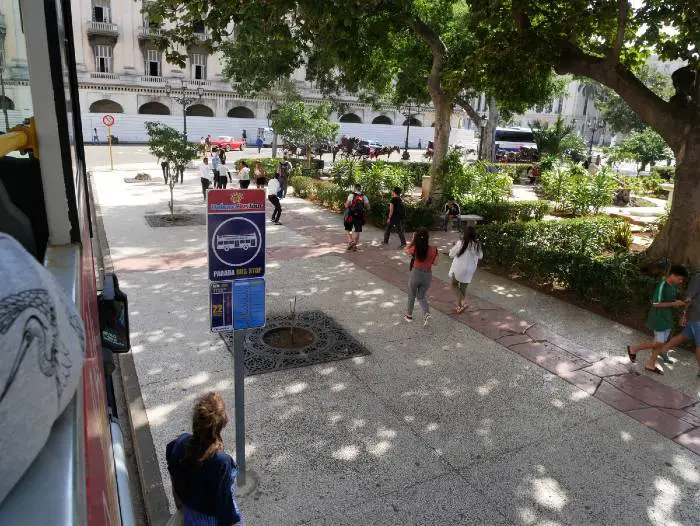
One of the most convenient ways to experience the different sights (and sites!) whichever country you visit, the Hop-on, Hop-off buses (often shortened to ‘HOHO’) in Havana is a fun adventure sure to thrill both adults and kids. If you’re not familiar with this must-do activity for tourists, HOHO buses are the big red double-deckers that ride through popular tourist attractions for all ages.
The tour typically starts in Parque Central, and along the way, it passes by these notable locations:
- El Malecon
This beautiful esplanade is the perfect spot for vivid sunrises, breathtaking sunsets, and everything in between. - Plaza de la Revolución
The colossal monument located here includes a statue of the Cuban national hero José Martí, and you can even take the lift to the top of the tower (the highest point in Havana) for a truly magnificent view of the capital. - El Cementerio de Cristóbal Colón (aka La Necrópolis de Cristóbal Colón)
The Colon Cemetery boasts some of the most beautiful designs and architecture of its kind, anywhere in the world. The Cuban sculptor José Vilatra de Saavedra’s Gate of Peace (“La Puerta de la Paz”) marks the main entrance of the cemetery, and other notable and storied sculptures such as La Milagrosa and Monumento a los Bomberos are found here. - Gran Teatro de La Habana
The stage of the Cuban National Ballet and one of the most exquisite attractions in Cuba, a tour of the grand theater costs only $5 per head, and it’s well worth the price to truly understand the importance, history, and grandeur of the place. - Castillo de La Real Fuerza
The Castle of the Royal Force is officially the oldest preserved fortress in Latin America, having originally been erected between 1558 and 1577. It served as one of the most important strongholds against pirates and English attacks during the 17th century.
Go to the Beach (Take the Other Hop on Hop off Bus)
If you and the kids prefer beaches to swimming pools, then Havana has got you covered! You can take the T3 HOHO for just $5 per head and arrive at the beautiful Playas del Este beach! This location spanning across the town of Santa Maria is fairly popular among the locals but isn’t as widely known to tourists as of yet.
For other travel options, you can take a shared taxi for about $3 per head, or a private taxi that nets you about $15 to $20 one way.
Pics + Play at Parque Cespedes
Céspedes Park serves as the centerpiece for Santiago de Cuba, so it shouldn’t be surprising that the place is pulsating with life from morning until night. It’s a worthy visit just to witness the traditional danzón performance to really get a sense of old Cuba and its rich history.
It’s a place populated with beautiful infrastructure so adults and adolescents will have a grand time enjoying the sights and taking pictures for their socials. With the ample space, kids can even run around and play soccer and tag with proper supervision!
Visit Fusterlandia
A whimsical place worth visiting regardless of your age, Fusterlandia is Cuban artist José Rodríguez Fuster’s brainchild. At first, focusing only on decorating his own studio, Fuster, with the permission of his neighbors, began decorating the homes and establishments in his neighborhood as well.
Today, some 30 years since he began, his distinctive art has enveloped pretty much the entirety of Jaimanitas, and tourists and locals alike can’t get enough of the place enchanted by his art.
Where to Stay in Havana with Kids
Casa Particular, or private house in English, are basically AirBnBs minus the actual posting on the website. For a truly authentic experience, we recommend booking one where the casa owners stay nearby.
Aside from being the much cheaper option compared to hotels (most casas only cost around $10 to $30 per room/night), you will also enjoy the guidance, home-cooked meals (at times included in the package, sometimes separate for a small fee) recommendations, and experienced insights of the locals.
Casa Otto y Mylena
A favorite of mine located in the Vedado neighborhood of Havana, Casa Otto y Mylena is the namesake’s former home (since converted for visitors), and it is one of the best bang for buck places to stay in Havana.
Otto and their housekeeper Yoly personally prepare delicious, home-cooked breakfasts served on their scenic wrap-around balcony. Otto is also a very personable host; he patiently answers any and all questions you and your family may have with a genuine enthusiasm. The place itself is also spotless; all thanks to Yoly!
Casa Mirador La Colina
The Casa Mirador La Colina is AirBnB host Aymeé’s three-guest private room, and it is situated just in front of the University of Havana. For the affordable price of just $33 a night inclusive of cleaning fees, this casa particular offers great convenience as it is located near a number of popular attractions. The rental package also comes with wi-fi, a private kitchen, and a washer.
Always clean, and always comfortable, it’s just as exciting to stay in and relax at this casa as it is to walk outside and experience the best Havana has to offer. It has a rating of 4.96 our of 5 at almost 300 reviews, so you know you’re getting your money’s worth by staying here.
Casa el Arco
Located within Habana Vieja itself, the Casa el Arco was built in the colonial era (1836, to be exact) and was originally owned by the Marquises of Bertrán; directly related to the house’s current owners. They offer two bedrooms, each with its own private bathroom, plus hot and cold showers available 24 hours a day. One of the rooms has a max capacity of 4 occupants, which is perfect for a medium-sized family.
They also offer a delicious breakfast service for a small fee of $5 per person, and dinner service for about $8 to $10.
Where to Eat in Havana
You’re definitely going to crave some authentic Cuban cuisine during your time in the city. The journey will never be complete without sampling a few of the most remarkable restaurants and cafes in Havana for kids and the whole family! Take your tastebuds on a tour with these culinary go-tos that have been tried and tested—all of which are family-friendly.
El Cafe (Habana Vieja)
Fresh fruit, warm sourdough bread, bacon and eggs, and some of the best espresso I’ve ever had, all served in a cozy space for an affordable price; what’s not to love about El Cafe? Though there’s a good chance that the casa you’re staying in offers a similar menu, it’s still worth the visit to experience a nice brunch around the locals.
Don’t even get me started on their sandwiches! No matter your food preferences, their vegan sandwiches are sumptuous! You really can’t go wrong with home-baked bread.
La Vitrola (San Ignacio, Havana)
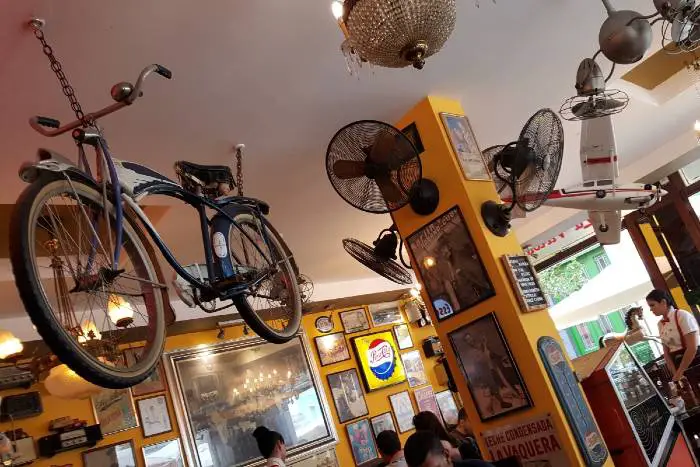
A great mid-priced lunch option, La Vitrola has a wide variety of full meal options, so you’re sure to find something for each member of the family. The excellent live music really adds to the pleasant atmosphere, and the warm, bright interior makes it a comfortable place to have a meal with the kids!
The Cuba Club Sandwich and the Java Juice are a couple of must-tries. If you’re looking for a more traditional selection that can accommodate your little one’s taste buds, then this is the place to be! There’s also a sister restaurant that exclusively serves pizza if it suits your appetite.
Casa Mia Paladar (Vedado)
You won’t easily forget Casa Mia Paladar with its exceptional service and wonderful views from the balcony. The menu tickles your taste buds with its delightful and affordable selection, and it’s also great to know they provide a diverse set of vegetarian and vegan-friendly dishes!
The servings are quite hearty and generous, so you don’t have to worry about your kiddos feeling unsatisfied. The food is well-priced for its quality (we recommend the melt-in-your-mouth seafood!), and you can really taste the freshness of the ingredients while dining in comfort. Don’t forget to make dinner reservations because it’s usually fully booked.
El Cuarto de Tula (Vedado)
El Cuarto de Tula boasts a fusion of international and local cuisine served in ample portions! The cozy, spacious, and clean interior is great for families, and it’s an excellent breakfast option where you’ll be served a traditional meal with fresh fruit on the side.
Do try their chicken-and-vegetable risotto and baked pork for a memorable and flavorsome experience. Your kids will love them too! The desserts are also nice, and the fact that you can connect to the internet here is a plus since you can’t have that everywhere in the country.
Paladar Los Mercaderes (Habana Vieja)
Authentic and just plain beautiful, Paladar Los Mercaderes seems to have it all: phenomenal and healthy dishes, superb staff, a homey interior, and a great location. You’ve got to give it a try if you’re staying in Havana; we know we’d visit again if given the chance!
The family-run restaurant is very accommodating menu-wise as it offers plenty of meat-free or gluten-free options. The vegetarian and vegan dishes, such as the mushroom risotto are quite delicious. Said to serve the best lobster in Havana, you should also try having lobster tacos with fresh fruit juice—a match made in heaven for visitors of all ages!
How to Get Around Havana
We can’t deny that getting around Havana is going to be a bit of a challenge! There’s no metro train system in the city, so you’re going to have to ride taxis, tour buses, or other private vehicles during your stay. It’s always best that you negotiate a fare before you get in the car, so we hope your haggling skills are on point!
Do note that we don’t recommend getting on Guaguas (regular buses) because they are almost always full and have unmarked stops. You’ll feel safer and much more comfortable riding HOHO buses and private vehicles such as taxis and vintage cars.
Bicycle Taxi
Bicycle taxis, or bicitaxis, are best for getting around in Habana Vieja where some of the routes may be too narrow. They’re great if the destination is walkable and you don’t want to tire yourself out too much under the beating Cuban sun. They normally cost around $1 to $3, but always make sure to agree on a fixed rate before you get in!
Coco-taxi
Weird, overpriced, and dangerous—Coco-taxis is a big nope. These are the perfect example of a tourist trap because, frankly, not even the locals themselves would dare to ride one. If you ever feel interested in riding one, all we can say is this: don’t. There are a lot of other ways to get around in Havana that don’t involve substantial risk to your safety (and wallet)!
Classic Car
Tourist vintage cars are a luxurious way of riding around in style in the city! If you have the budget, they’re surely worth the experience as you’ll feel fabulous with the wind in your face. They cost around $40 an hour, but you can surely negotiate a discount if you’re going to rent them for longer. Don’t forget to take pictures worthy of being on a magazine cover!
You might also find really old cars called almendrones or máquinas that stop along their route, and these are technically shared taxis that will accommodate you as long as they have space. However, some very unfamiliar hand signals are used by locals to show where they want to go, so you’re going to need some help from a native with this one.
Regular Taxi
“Regular” taxis in Havana are the yellow vehicles called ruteros and metrotaxis. Their routes and destinations are stamped below the windscreen, so you’ll know which ones to take based on the next stop of your itinerary. Make sure to agree on a fare before you get in, though. If you don’t negotiate and get in without a word, you might get charged an exorbitant amount by the time you reach your location!
Trust us, a bit of haggling will go a long way, so brush up on your Spanish! You can generally find taxis waiting in front of a hotel, and there are plenty to come around if you’re in Vedado.
Hop-On Hop-Off Bus
The Hop-On Hop-Off or HOHO buses feature guided city tours that will take you through all of the most famous attractions across Havana. This is a suitable means of transport for those who don’t want to miss out on the sights and want some extra assurance on their trip! By taking HOHO tours, you don’t have to worry about where to go next or losing direction.
Costing only around $10, the tour bus sure is convenient, but it’s best for those who plan on making only quick stops and have limited time on their trip. If you want to stay longer in some areas and have much more time on your hands, you might want to design your own itinerary and use other means of transport!
Make sure to get on a bus with good air conditioning because it can get pretty warm in the summer. Also, don’t forget to bring sunscreen, especially if you’re bringing kids along!
Havana with Kids: What to Bring
Taking your little ones to a foreign country is an entire challenge in itself, but it’s certainly no issue as long as you’re prepared! Depending on how big your kids already are, you’re going to pack some additional essentials (carriers or strollers, diapers, and the like) to make sure your trip doesn’t go awry.
Of course, don’t forget to bring plenty of sunscreen for both you and your kiddos! Their delicate skin is going to need ample protection against the soaring temperatures and the Cuban sun. Also, if you plan on going to the beach, you might like to pack some lightweight children’s snorkeling equipment to bring out the underwater explorer in them!
Havana with a Baby
I always bring a carrier anywhere knowing that I have my little one with me. Baby carriers are a must if you’re going to be traveling long distances to unfamiliar environments. Although there are lightweight strollers out there, they aren’t cut out for uneven terrain—something which you will undoubtedly encounter not only in Havana but also in any other country.
Apart from being more convenient, they’re actually great for the baby’s back, emotional development, and safety as you’re literally holding them close to you all day long. As an avid fan of carriers myself, I can’t stress just how amazing and easy they are to handle!
Needless to say, baby powder, diapers, pacifiers, and baby bottles are all part of the usual deal. These are the things that are practically impossible to forget!
Havana with a Toddler
Although toddlers are a bit heavier, I’d still recommend toddler carriers over strollers! Just make sure you get an ergonomic one with the right fit, so you have no chance of hurting yourself or your tot’s back.
Do bring a snack cup and sippy cup because everyone knows just how much they love spilling their food and grabbing stuff; we wouldn’t want them near delicate glassware in a restaurant! If you can, a travel-friendly high chair and bed are great for additional assurance.
Best Time to Visit Havana
The dry season in Cuba runs from November to April, so it’s generally fine to visit the country during these months instead of May to October, the hurricane season. That said, the best months to visit Havana are January to February, as temperatures are at their lowest during this time of the year. Make sure to book accommodation way ahead of time as it’s peak season!
Another consideration, are the holidays and festivals that occur only during certain times, such as the August carnival. The rains should be starting to subside a bit by this month, but the warm, humid temperature will persist.
Other events of interest include the Days of Cuban Culture and the international Havana Ballet festival, both of which you can experience from October to November, and the film and jazz festivals, which both take place during December.
To sum it all up, if you’re not looking to go see a particular festival, then taking your trip to Havana from January to February is the best choice!
Getting to Cuba
Entering any country is going to take a bit of effort in gathering the necessary documents, but it’s definitely nothing to freak out about! To take off some of the burdens, we’ve outlined the visa requirements and the details you might want to consider below in deciding how you want to reach Cuba.
Visa Requirements (Worldwide + US)
All tourists—except for a few depending on their citizenship—need to apply for a tourist visa (also called a tourist card) to enter Cuba, which costs anywhere from $25 to $85 depending on your country of origin. You can get one from the Cuban consulate or from a travel agency or airline as part of a travel package.
If you’re a citizen of any of the following countries below, luckily, you won’t need to apply for a tourist visa as long as you’re staying short-term and have a passport! The maximum number of days depends on the country as outlined. Do note that citizens from Namibia can stay for an undisclosed amount of time also without the need for a tourist visa.
| Up to 90 days | Up to 60 days | Up to 30 days | Up to 28 days |
| Bosnia and Herzegovina | Grenada | Antigua and Barbuda | Barbados |
| Kenya | Saint Vincent and the Grenadines | Belarus | Dominica |
| Malaysia | Mongolia | ||
| Montenegro | Saint Kitts and Nevis | ||
| North Macedonia | Saint Lucia | ||
| Russia | Singapore | ||
| Serbia |
If you’re a citizen of any other country, you’ll need both a passport and a Cuba tourist card. In getting the card, you’ll need to provide your passport number, home address, the address of your booked accommodations in Cuba, and the information on your confirmed flights. Don’t lose your card during your trip as you’ll also present it upon departure from Havana! If you ever lose it, you’re going to have to wait a few hours to be cleared.
The tourist card will allow you to stay up to 30 days (90 days if you’re a Canadian citizen!), but you can renew for another 30 days at a hotel desk or immigration office in Havana if you intend to stay longer.
If you’re American, you’re going to need a bit more effort as the ties between Cuba and the USA are not that great. You’ll have to provide a detailed itinerary of your visit and keep all Cuban travel receipts (unless you have a specific purpose for traveling such as work and education), but the hassle should still be worth it in the end!
By Plane
The most common way of getting to the Caribbean paradise is via plane as it’s the fastest and most convenient option there is. There are plenty of international flights to come about, especially if your destination is Havana, where the José Martín International Airport (the main airport in the country) is located.
Another international airport in Cuba is Antonio Maceo, which can be found in Santiago de Cuba. Once you arrive at the airport, your only option to get to your accommodation would be via taxi as there are no regular trains or bus rides to and from the city center.
By Cruise Ship
An advantage of traveling by cruise ship is that there are plenty of seaports in Cuba directly connected to the city centers, so you won’t have to travel very far from your drop-off point as compared to getting there by plane.
Of course, the other main reason for this means of travel is that it’s also part of the vacation itself! Although it may take longer, you can already relax and comfortably enjoy your journey to the wonderful country that is Cuba.
Practical Tips
Reading about stuff is vastly different from actually experiencing it, and I’m confident to say that we’ve had plenty of surprises during our travels around the world! To help you with “expecting the unexpected,” here are a few practical tips for every unsuspecting fellow tourist out there.
How Do You Pay For Stuff?
This is pretty important stuff (especially for US citizens), so we urge you to go through the details! We’ve summarized the main points below:
- Bring cash!
- Exchange currencies at an unofficial (informal) moneychanger.
- US debit cards, credit cards, and online banking are unusable.
I always bring cash with me when visiting because ATMs can be scarce, and even if you do find one, lines can get pretty long. If you must access your account while in Cuba, ask your accommodation host about where to find the nearest bank or teller machine.
The only official currency in the country now is CUP (Cuban Peso; $1 = 24 CUP). You can’t get CUP outside of Cuba. You can only get CUP once you’re in the country, so it’s highly advisable that you bring a suitable amount of money to exchange.
You might have come across some articles still showing payments in CUC (Cuban Convertible Peso; $1 = 1 CUC), but that’s only because it became obsolete in 2021—CUC is now unusable.
All currencies can be exchanged for CUP, and you should do so at the start of your trip. Communicate with your accommodation host to have a moneychanger come to where you’ll be staying for your convenience and safety. They are unofficial moneychangers (because they’re part of an informal market), but the entire process is completely legal.
Casa de Cambio (CADECA), which literally means “money house,” is the official moneychanger across the country that will exchange currencies at a fixed rate of $1 = 24 CUP.
We recommend that you stick with unofficial moneychangers because you can get a lot more value from the exchange as they adjust the rates for inflation. For example, for $1, you might even get around 45 CUP—so much more than the fixed rate of 24 CUP at the airport or official moneychangers.
The hassle with exchanging is why you should estimate your budget beforehand and constantly check how much you’ll be spending each day! You want to exchange just enough money for the length of your entire trip.
If for some reason, you run out of CUP and can’t get it exchanged fast, many stores and locals will still accept US dollars and Euros as payment.
Because Cuba’s ties with the US are well-known to be “shaky” at the very least, US debit and credit cards can’t be used in the country. Online banking is also difficult, so really, your best option is to bring cash and have it exchanged at an informal moneychanger!
Don’t Forget to Tip!
Tipping is a part of Cuba’s culture, so don’t wonder if you see bills and change being given at the end of every tour, meal, assistance, or practically any other service! Make sure to spare a significant portion of your budget for tips, and always have small bills and coins in your wallet. $1 to $5 (around 20 CUP to 100 CUP) will usually do for most services.
Tipping at stores is pretty common—you don’t have to spare more bills and coins here as you can just tell the cashier to keep the change. As for restaurants, around 10% of the bill is usually a good measure for tips if the fee doesn’t include a service charge.
Up to 100 CUP is great for taxi drivers and tour guides, but do go higher for longer hikes and more difficult tours. Parking valets and toilet attendants can go for 20 to 50 CUP.
¿Es tu español bueno?
Brush up on your Spanish! In visiting any country, learning about the mother tongue or even knowing at least some of the most used key phrases works wonders. Besides, it’s part of the adventure, and it’s great to have a more intimate experience with the locals by understanding their language and tradition.
A major plus side of being able to hold a conversation? I’m sure that locals will certainly be happy to know that you’ve put in the effort to learn their culture and way of life! Of course, you don’t have to be fluent, but it’s nice and easier to connect with people by simply being able to deliver the most basic greetings and pleasantries.
Where’s the WIFI?
If you’re hoping to post an Instagram story or go live on Facebook during your trip, you might want to know that it’s easier said than done. Expect that you’ll need some extra effort in connecting to the internet within Cuba!
Mobile data isn’t prevalent in the country, so you’ll have to get a one-hour internet pass at an ETECSA center for your wifi needs. On top of that, wifi signals are accessible in only a few locations.
An internet pass in Havana costs around $3, and locals and tourists alike frequent La Rampa (Avenida 23) in Vedado to have their social media fix. It’s a bit of a hassle, but on the plus side, everyone will likely have much more time to connect with each other instead!
Want Ice Cream?
Kids are bound to scream for ice cream! You might have already heard about Coppelia, an ice cream parlor in Vedado that is one of the largest across the globe. The ice cream is definitely good and prices are low, but if you’re traveling with kids and the family, it might not be worth your time.
The lines are almost always pretty long, there are only a few flavors available, and for some reason, the queues for tourists and locals are separate (probably because tourists are expected to pay a higher rate). Service is also notorious for being not that great in some instances.
There are other good choices such as Helad’oro in Old Havana; they’ve got great ice cream and gelato, diverse flavors, and very reasonable prices!
FAQ
Is Havana good for kids?
Havana is a beautiful place to immerse your kids in an educational, recreational, and cultural experience at a young age. From parks to museums, there are many activities and places for your kids to enjoy their stay.
Is Havana safe for children?
You can find open spaces, especially plazas, filled with children playing who are sociable. Being in Havana and meeting the locals also provides a great opportunity for your kids to play and meet new friends.
Is Havana good for families?
Havana is also home to several family-friendly museums and parks. The whole family can enjoy a good stroll, photo sessions, and tours together.
Final Words
As a mother who’s visited Cuba with our little girl, let me tell you that Havana and kids do mix! Beautiful parks, relaxing beaches, delicious food—this should be all the more reason for any parent to share the fun with their family. Rest assured that you definitely won’t have any major issues with the right mindset and the proper preparation when in Havana with kids. Bring them along on your adventure, and your kids might have a grand time without you even realizing it!
MORE CUBA CONTENT
- Cuba with kids
- 3 Best Places to visit for A One Week in Cuba Itinerary
- 15 Great Things to do in Viñales, Cuba
- Planning a Cuba itinerary: our amazing 24-day trip
Mums on Flipflops is a participant in the Amazon Services LLC Associates Program, an affiliate advertising program designed to provide a means for sites to earn advertising fees by advertising and linking to amazon.com, amazon.co.uk, amazon.ca, amazon.de, amazon.fr, amazon.it and amazon.es. Amazon and the Amazon logo are trademarks of Amazon.com, Inc. or its affiliates.

ABOUT THE AUTHOR
Babs Rodrigus is the co-founder and main writer of Mums on FlipFlops . She is absolutely crazy about traveling – especially together with her wife and kids. Babs loves animals, chocolate (what did you expect from a Belgian?), reading, and writing.

ABOUT THE AUTHOR
Babs Rodrigus is the co-founder and main writer of Mums on FlipFlops . She is absolutely crazy about traveling – especially together with her wife and kids. Babs loves animals, chocolate (what did you expect from a Belgian?), reading, and writing.

